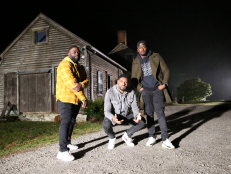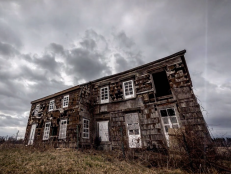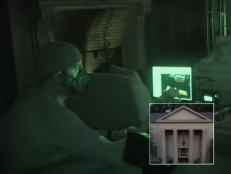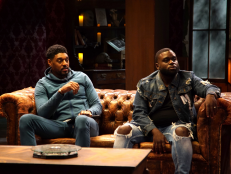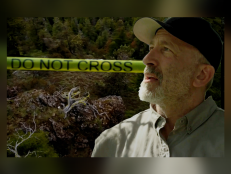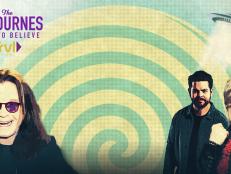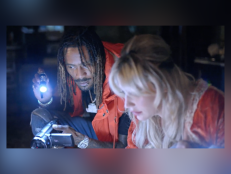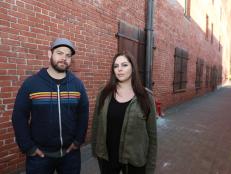Bizarre Foods Episodes
Sensory Overload
Andrew Zimmern takes a look back at the foods that have sent his senses into overload, from those with a strong smell, strange taste or funky texture, to those that looked just plain weird or should never have been made in the first place!
Dangerously Delicious
Andrew Zimmern’s pursuit of a great meal often leads to danger. From poisonous foods to scary situations, Andrew looks back on the many times he put his life at risk in his quest to make a new food discovery.
Slither, Creep & Crawl
Andrew looks back at eating creatures most people don’t think of as food. From fried tarantulas and maggot-filled cheese to giant fruit bats and king cobra soup, Andrew’s not afraid to eat foods that creep, slither and crawl.
Tribal Tastes
From drinking clotted cow blood with the Maasai in Tanzania to eating whole prairie dogs with the Zia in New Mexico, Andrew Zimmern looks backs at the memorable food and experiences he's shared with different tribes all around the world!
Hunt, Kill, Cook
From shooting blue wildebeest in Namibia and wild boars in Hawaii to gigging for hog suckers in the Ozarks, Andrew takes a look back at some of his most memorable hunting and fishing trips from around the US and the world.
Critters
From skinning a muskrat in Maryland, Beaver chili in Maine and cooking up stir-fried rat in Thailand, Andrew's talking about, and tasting, all things critters. Hair, tails, and nails included.
Global Grocery
From meat and seafood to dairy, bread and snacks, how we get our food often depends on where we live. Straight from the sea or fresh from the udder, Andrew Zimmern gives us a taste of his global grocery experiences.
Everything but the Squeal
From raw pig's blood in Bali and ground pig snouts, ears and tongues in Cleveland, OH, to cured pig legs in Sardinia and pig face bacon in Los Angeles, Andrew Zimmern recaps his favorite porcine finds.
Working for Food
Andrew Zimmern looks back on all the times he's had to earn his food. Whether it's making kimchi on the factory line, harvesting clams right off the ocean floor or inseminating Alaskan salmon eggs, Andrew works for his food!
From the Vault: Volume 1
From the lost clips to behind-the-scene moments with the crew, Andrew Zimmern shares some of the footage that's never made it into any other Bizarre Foods episode. Mishaps, practical jokes and fantastic foods are all part of the fun!
From the Vault: Volume 2
Andrew Zimmern is back with another round of never-before-told-stories and behind-the-scene moments with the crew. From hot wings in Chicago to Muskrat pate in Detroit, Andrew reveals some of the foods that didn't make it into the show.
Hard to Swallow
Mystery meat and fermented fish make the list as Andrew Zimmern looks back on the most challenging foods he's encountered. From putrid smells to gelatinous textures, Andrew admits to the foods that have been the hardest for him to swallow.
Cooking with Fire
In his travels around the world, Andrew has learned that many cultures still cook like their cavemen ancestors. All it takes is a flame, a pile of wood and an animal, and you've got dinner.
No Cooking Required
Andrew looks back on some of the memorable foods he's eaten raw during his travels. From Elk heart to horse mane to buffalo breast, Andrew has found that enjoying some of the freshest foods means there's No Cooking Required.
Factory Food
Just because food is factory-made, doesn't mean it's not created with loving care. Andrew Zimmern goes behind the curtain at factories across the globe producing artisanal and strange foods, from jelly beans to blood pudding to escargot.
Ethnic Enclaves
Whenever a local community opens its arms to immigrants, great things can happen, especially in the world of food when those new ethnic groups bring their culinary traditions to new places. Deep in the American south, there are several of Vietnamese introducing their new homes to Asian tastes. Andrew visits a group of Vietnamese immigrants cooking bahn gio, a rice porridge stuffed with spicy port, black fungus and vegetables steamed in banana leaf, and pizza made with duck blood and offal. In Alabama another Vietnamese community shares their tradition of fermented fish and pork belly. While in Mississippi Andrew meets Kim Wong and his family who started a small factory churning out pork rinds and chicken skins using old world Chinese cooking techniques paired with modern packaging and distribution channels. Tastes of Asia have also migrated to the Midwest. In Minnesota, Hmong people from Laos have established their own thriving markets and restaurants. Andrew samples a bitter bamboo soup and heaping plate of pig intestines that he describes as "livery and a little bit poopy." Dearborn, Michigan, is home to the one of the largest concentrations of Arabs living in the U.S. and they treat Andrew to a post Ramadan feast of stuffed lamb stomach and Lebanese raw meat dishes. In Louisville, Kentucky, Andrew meets a "double" immigrant: Chef Edward Lee, of Korean heritage, born in New York, moved to Kentucky. He cooks up the game he's hunted, including rabbit and venison in an Asian style neck bone soup, along with frogs legs finished with bourbon and fish sauce. Nashville, Tennessee has its own surprising immigrant group - Kurds from the mid-east. Andrew tries his hand at baking Kurdish bread and then joins a Kurdish family for a meal of dumplings and greens that need to be stripped of potentially poisonous toxins before cooking. Andrew finds some surprising traditions in Denver, Colorado, brought by families originally from Mongolia. They've erected a "ger," a traditional hut in their backyard, where they share holiday meals. They invite Andrew to eat Khorkhog, a whole roasted sheep cooked with hot rocks, almost like they do it in Mongolia, served with stomach and lung salad. There are very different cooking styles in Dallas, Texas, within the huge Russian community there. Andrew experiences a Russian banya, or sauna, and then chows down on traditional savory Uzbek pastries and a herring salad. Dallas is also home to eleven thousand Thai immigrants who gather and shop in a handful of specialty stores where you can find water bugs and fermented eggs. Andrew joins a local family for dinner including those bugs chopped with shrimp paste lime, century eggs and Thai chilies and stink beans. One of Andrew's favorite finds is the Indian enclave in Houston, where dessert is a plethora of sweets made of various combos of boiled milk, sugar and syrups. And finally, it's not just the U.S. that boasts thriving immigrant communities. Case in point is Peru, which has incorporated long past influxes from both China and Japan into the fabric of its society and culinary traditions. Nikkei and Chifa cuisines are world famous and Andrew meets a chef who is a master of both. Together they eat the frogfish massaged with Chinese fermented soybeans and Peruvian spices, along with a guinea pig fried Chinese style. In his Nikkei restaurant Chef Tsumara shows how sushi can be married with Japanese flavors and styles, and egg yolk injected with ponzu served with wagyu beef. Andrew suggests everyone look in their own towns for ethnic cuisine and share a meal with the folks who make it possible.
Food Science
Andrew Zimmern explores how the marriage of cooking and science is producing eye-popping discoveries.
BBQ
Andrew samples a dozen different barbeque styles around the world, from a buffalo meat tailgate party to Texas pit BBQ to a pig roast in South Carolina, barbequed mutton in Kentucky to chicken hearts in Peru and pork in Korea.
Comfort Foods
Comfort foods remind us of home, and Andrew samples all sorts, from a grandma's recipe for chopped hogs head in Belize, chitterlings in the American south, Vietnamese pig uterus soup and the world's oldest ice cream in Syria.
Cold Blooded Creatures
The usual reaction to snakes or crocodiles is to run, but Andrew Zimmern catches and cooks them, eager to try everything from boa constrictors in Nicaragua to poisonous toads in Australia, to giant snapping turtles in Pennsylvania.
Continental Classics
Despite the onslaught of globalization, there are still groups around the world that cling to the food traditions of their ancestors. Andrew visits those pockets of authenticity to sample classics of every continent. In Asia, he prowls the street markets of Beijing, China to taste crispy grilled cicadas and raw sea urchins. Andrew meets Chef Luu Meng in Phnom Penh for a typical Cambodian meal made with their traditional fermented fish paste, and in Thailand he visits a small village to see how the famous Thai fish stomach sauce is still made by hand by women gutting fish on the ground outside their small huts. Islands of the Pacific offer a different fish experience and Andrew finds a family that still makes Hawaiian dishes the old fashioned way, by scraping the spine and blood line of tuna. Off the coast of Samoa, Andrew catches giant yellow fin tuna with Captain Alfred, and gets to try a beating heart cut from his catch along with a traditional Samoan delicacy of palolo, or spoiled worm paste. And Australia offers a wide range of classic dishes at the Darwin Mindil Beach market, where Andrew samples skewers of meat from crocodile, emu and camel. Africans give Andrew a warm welcome starting with the village of Lwanika in Uganda, where they have no refrigeration, so he eats goat meat smoked and salted, along with matooke, which are steamed green bananas and goat stomach lining and intestines. In Tanzania, Andrew stokes up for a full day of climbing with a breakfast of Supu, a soup made of multiple animal innards including goat lungs, heart, liver, cow intestines, tongue and tail. Some of the most iconic foods of Europe are getting harder to find these days, as Andrew discovers when he hunts for bull testicles, made famous by Spanish bullfights. But he finds some fresh bull balls in Madrid's Mercado de la Paz, and gets them cooked at a nearby stall in the market. In Venice, Andrew takes to the Lagoon to fish for the traditional cuttlefish, used in many dishes there. But he gets more than he bargained for when the cuttlefish refuses to give up quietly, and bites back. In South America's quintessential party town, Rio de Janeiro, Andrew gets a samba dance lesson at a huge community fundraising bash called a Feijoada party, where he eats heaps of the main dish, a stew of every part of the pig and cow, from feet to tripe to tail. In the Bazurto market of Cartagena, Colombia, Andrew finds traditional specialties like turtle, chicken and rodents, normally stewed with coconut milk, peppers, tomatoes, onions and vinegar. And in Lima, Peru, Andrew chokes down a few gulps of a frog milkshake, a health drink handed down through the culture of the Andean mountains. And finally, North America has so many diverse cultures, each with its own iconic foods. He visits the rural sugar shack of Montreal chef Martin Picard for a feast where everything is coated or cooked in the maple syrup Picard taps on the premises. It's a huge change of scenery and culinary pace when Andrew stops at the Big Apple Inn of Jackson, Mississippi, for their signature pig ear sandwiches. And finally, Andrew goes along with the Aaron family to trap muskrats on the Chesapeake Bay, learns how to skin them and remove the noxious musk gland, and then how to cook them with a generations-old recipe.
From the Vault: Volume 3
Andrew shares more of the unforgettable moments from the road that never made it into the show. From eating pig brain in Vietnam to sipping honey water in Mexico, these never-before-seen moments are too good to miss!
Once in a Lifetime
Through the years, Andrew has had some incredible food experiences that only happen once in a lifetime. From maggot cheese in Nicaragua to slurping live langoustine in the Faroe Islands, Andrew recalls meals that can't be matched.
Family Business
Andrew learns that hard work runs in the family when it comes to family-run food businesses. From harvesting caviar in Florida to serving moose pot pie in Newfoundland, food just tastes better when the family legacy is at stake!
Food Adventures
The best food experiences are often served with a side of adrenaline. From midnight spearfishing in the Alaskan wilderness to eating poisonous vipers in Philadelphia, Andrew goes out of his comfort zone to find the best bites.
If You Can't Beat'em Eat'em
Andrew does his part to help restore the planet's natural balance one meal at a time. From tossing rocks at pigeons in Virginia to bowfishing carp in Minnesota, Andrew combats nature's most troublesome pests with a knife and fork!
Spoiled Rotten
With many dishes, spoilage is a good thing and letting food rot can work wonders! From decayed lamb in the Faroe Islands to 32-year-old Korean bean paste to Peruvian rotten potato cheese, Andrew samples rotten food from around the world.
Street Foods USA
From food truck tongue tacos to state fair fried alligator, Spam sushi to elk sausage, Andrew Zimmern hits the streets to find the best street foods offered from coast to coast and everywhere in between.
The Great Food Frontier
From pioneering chefs to revolutionary flavors, Andrew Zimmern reveals the rebels throwing the recipe book out the window with pine cone ice cream, camel ribs and more.
Street Foods Asia
From Buffalo brain stew in Delhi to water snake in Cambodia, Andrew Zimmern explores Asia's best street foods.
The Business of Food
Andrew Zimmern rolls up his sleeves to experience the effort behind some Bizarre Foods favorites. From the factory making Sriracha to a restaurant creating bird nest soup, the business of food takes work.
Art of Survival
Andrew Zimmern explores the ancient foodways that modern life tries to bulldoze into oblivion. Thanks to the proud few keeping these customs and cultures alive, Andrew goes to Chile to eat fresh lamb's blood, hunts rabbit with trained eagles in Kazakhstan, attends a Namibian tribal goat slaughter and nets Tiber River eel with Rome's last eel fisherman. This is a tribute to the heroes around the world fighting to hold onto vanishing traditions that open up a living link to our past.
Street Foods Worldwide
Andrew Zimmern explores global markets to find locals' favorite foods. From cow skin and chicken foot soup in Jamaica to Moroccan camel ribs and Panamanian iguana eggs, market foods always reflect the truest taste of a country.
What's Your Beef?
Andrew explores beef-eating cultures around the world. From whole cow head BBQ in Texas to Guatemalan cow eyeball cocktails, raw bull penis in Bangkok to fresh blood in Tanzania, craving cow is a tradition all over the world.
Frozen
Andrew Zimmern travels to some of the coldest places on Earth to see how people survive and eat. He seeks out delicacies like muffler meat and hand-pried sea cucumber -- an array of deliciousness that's sure to beat the chill.
Eat Bugs ... Save World
Andrew Zimmern ventures into the world of eating insects as a source of protein. From coconut grubs in the Amazon to dung beetles in Thailand, Andrew finds that bugs are a great food source in many places around the world.
Whole Hog
Andrew Zimmern celebrates the world's greatest edible animal by digging into every part. From year-old cured ham to deep-fried testicles and melts-in-your-mouth snout sandwiches, the hog provides unmatched versatility.
By Grandma's Hands
Andrew Zimmern travels the globe to eat the simple and loving foods prepared by grandmothers' hands. He crashes their kitchens to feast on matriarchal recipes, including marinated armadillo, raccoon in possum juice and boiled seal meat.
The Great Outdoors
Andrew Zimmern travels the world on a hunt for the planet's most delicious game. He eats black bear skin cracklings in Arkansas, pan-fried nutria in Louisiana and wildebeest organs, including an eyeball, in Namibia.
How It's Made
Andrew Zimmern circles the globe to discover food making processes old and new. He helps make and eat traditional longevity noodles in Taipei, olive oil on a Moroccan mountainside and true ham in Paris.
World's Best Markets
From sweet street waffles and fried bamboo rat to mystery meat and stewed brains from a lamb's skull, Andrew Zimmern reveals how market eats from around the world showcase a city's history and cultural pride.
Playing With Fire
Andrew Zimmern travels the world to see how cultures use innovative techniques to harness the power of fire for culinary masterpieces like sun-dried beef and African hornbill.
From the Vault: Volume 4
Andrew eats bloodwurst, head cheese and rattlesnake in this episode of previously unaired footage. Also featured is Andrew's scooter crash in Madrid, an 'ugly stick' performance in Newfoundland and a Bizarre Foods superfan in Okinawa!
Home Cooking
From Jamaican-infused Chinese food to backyard-trapped woodchuck and stone soup starters, Andrew samples some of the home cooking that brings people together and keeps traditions alive around the world.
Gone Fishing
Andrew explores the world's oceans, lakes and rivers and discovers a taste for what many fishermen throw back. He cooks and devours fried dogfish in Boston, pufferfish in North Carolina and scorpion fish in Houston before traveling to Rome's Tiber River to eat fresh eel and to Namibia for the oysters.
America's Coastal Treasures
Andrew explores America's coastal treasures, diving into sweet clams, smoked whitefish, cow nose stingray and feral hog meat.
Europe's Grandmother Foods
Andrew explores contemporary European gastronomy influenced by the foods and traditions of its grandmothers. He tastes generations-old dishes like fried calf brains, Italian tripe, fish meatballs and stuffed pig head.
Food Roots of the Americas
Andrew Zimmern heads out in search of three centuries of culinary history in the foods of the Americas. From Florida to Central America to South America, he finds out what dishes survived Spanish colonization and what was forever changed. From ancient ritual meals such as pachamanca to pork favorites like chicharrones, tamales made from the fish caught in the canals of Mexico City to sweets with heavy African influence from the slave trade, Andrew explores it all.
Caribbean Melting Pot
Andrew digs into the beautifully complex, multicultural foods of the Caribbean, including curried conch, Jamaican jerk and tree rat.
Eating Africa
Andrew takes a bite out of the ignored foods of Africa, including traditional pigeon pie in Fez, slow-roasted Ugandan cane rat and a nonstop meatfest with Masaai warriors in Tanzania.
Southern Food 101
Andrew Zimmern explores the diverse culinary traditions of the southeastern US, from age-old Cherokee recipes to foods brought over by the European settlers and dishes created by enslaved African Americans.
California Rising
Andrew Zimmern explores the diverse dishes and food trends of sunny California. Along this culinary journey through the Golden State, Andrew dines on cowboy sushi, sheep heart ragu, blood mousse and sea urchin genitals.
Backcountry America
Andrew explores the humble cuisine of America's remote mountain and swamp regions, including chicken-fried squirrel, beer-battered frog legs and stewed pig intestines.
Made in China
Andrew Zimmern explores the influence of Chinese cooking on world cuisine. He travels the globe as he eats culinary gifts such as pork rinds, chow mein, stinky tofu, Agu pork and dim sum.
The Farming Revolution
Andrew explores the exciting and sustainable small farm movement that's brewing across America. He samples some of their foods along the way, including chocolate "chirp" cookies, pickled beefsteak mushrooms and red dulse seawood.
What's New from TRVL
On TV
Stream discovery+
Your favorite shows, personalities and exclusive originals. All in one place.











